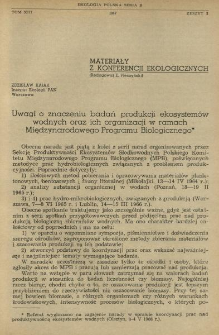- Search in all Repository
- Literature and maps
- Archeology
- Mills database
- Natural sciences
Advanced search
Advanced search
Advanced search
Advanced search
Advanced search

Object
Title: Uwagi o znaczeniu badań produkcji ekosystemów wodnych oraz ich organizacji w ramach Międzynarodowego Programu Biologicznego
Subtitle:
Uwagi o znaczeniu badań produkcji ; Materiały z konferencji ekologicznych ; Remarks on the significance of research on the production of water ecosystems and its organisation under the International Biological Programme
Contributor:
Polska Akademia Nauk. Komitet Ekologiczny
Publisher:
Place of publishing:
Description:
Pages 117-122 ; 24 cm ; Abstract in English
Type of object:
Abstract:
The paper was read as the opening address at the conference on co-ordination of studies of the productivity of warter ecosystems (Olsztyn, 3-4 May, 1966) organized by the Productivity of Freshwater Ecosystems Section of the Polish Committee of the International Biological Programme. The aim of the conference was to discuss and reach an agreement on methods of collecting and elaborating material for calculation of production and the ways themselves of calculating production. The use of prioduction instead of biomass or abundance gives a better description of biological processes and permits of better comparison of very different groups of organisms, which in turn makes it possible to analyse the channels through which energy flows and ecological effectiveness. It is of course obvious that in addition to the estimation itself of production it is essential, in order to understand its regularities in different situations, to analyse the biotic and abiotic factors determining the channels of flow of energy and ecological effectiveness. With the present scanty knowledge available of the rules of production, even a very approximate way of assessing production is valuable. Reliable collection of material is of fundamental importance. The actual calculation methods, often imperfect, are continually being improved and at the same time also simplified. It is essential to express production in comparable units, convertible to the most universal units, calories. It is also essential to calculate production per unit of area of the body of water (and not only, e.g., per unit of volume or weight of substrate); only this way comparison of different bodies of water ecosystems can be attained. Production of ecosystems may be investigated in ways varying in degree of detail: 1) only on ,,entry” and ,,exit” (primary production and influx of allochthonous substance on the one hand, and outlow of organisms and deposition of sediments on the other); 2) assessment of production of all trophic levels; 3) estimation of the production of all trophic levels based on analysis of factors determining production (habitat, quantity and quality of food, competition, predation etc.). Even investigations of the first degree, carried out on a large number of waters, may at the present stage of our knowledge supply much valuable information. Particularly interesting prospects are afforded by analysis of situations in which the ecosystem is subjected to intervention of some kind, such as artificial mixing heating of the water, fertilisation, acclimatisation and introduction of organisms etc. It would then be easier to discover the rules governing production, and at the same time to indicate the possibilities of directing the production. The final part of the article contains a discussion of research on production from the organization aspect, under the International Biological Programme.
Relation:
Volume:
Issue:
Start page:
End page:
Detailed Resource Type:
Resource Identifier:
oai:rcin.org.pl:127051 ; ISSN 0424-7205
Source:
MiIZ PAN, call no. P.3259 ; click here to follow the link
Language:
Language of abstract:
Rights:
Creative Commons Attribution BY 3.0 PL license
Terms of use:
Copyright-protected material. [CC BY 3.0 PL] May be used within the scope specified in Creative Commons Attribution BY 3.0 PL license, full text available at: ; -
Digitizing institution:
Museum and Institute of Zoology of the Polish Academy of Sciences
Original in:
Library of the Museum and Institute of Zoology of the Polish Academy of Sciences
Projects co-financed by:
Access:
Object collections:
- Digital Repository of Scientific Institutes > Partners' collections > Museum and Institute of Zoology PAS > Scientific Journals
- Digital Repository of Scientific Institutes > Literature > Journals/Articles
Last modified:
Feb 4, 2025
In our library since:
Jun 15, 2020
Number of object content downloads / hits:
60
All available object's versions:
https://rcin.org.pl./publication/101424
Show description in RDF format:
Show description in RDFa format:
Show description in OAI-PMH format:
Objects Similar
Pieczyńska, Ewa Szczepańska, Wanda Szczepański, Andrzej
Kajak, Zdzisław
Gliwicz, Zbigniew Maciej
Wiśniewski, Rajmund Jan
Woroniecka, Urszula
Stańczykowska, Anna
Gliwicz, Zbigniew Maciej
Pieczyński, Eligiusz

 INSTYTUT ARCHEOLOGII I ETNOLOGII POLSKIEJ AKADEMII NAUK
INSTYTUT ARCHEOLOGII I ETNOLOGII POLSKIEJ AKADEMII NAUK
 INSTYTUT BADAŃ LITERACKICH POLSKIEJ AKADEMII NAUK
INSTYTUT BADAŃ LITERACKICH POLSKIEJ AKADEMII NAUK
 INSTYTUT BADAWCZY LEŚNICTWA
INSTYTUT BADAWCZY LEŚNICTWA
 INSTYTUT BIOLOGII DOŚWIADCZALNEJ IM. MARCELEGO NENCKIEGO POLSKIEJ AKADEMII NAUK
INSTYTUT BIOLOGII DOŚWIADCZALNEJ IM. MARCELEGO NENCKIEGO POLSKIEJ AKADEMII NAUK
 INSTYTUT BIOLOGII SSAKÓW POLSKIEJ AKADEMII NAUK
INSTYTUT BIOLOGII SSAKÓW POLSKIEJ AKADEMII NAUK
 INSTYTUT CHEMII FIZYCZNEJ PAN
INSTYTUT CHEMII FIZYCZNEJ PAN
 INSTYTUT CHEMII ORGANICZNEJ PAN
INSTYTUT CHEMII ORGANICZNEJ PAN
 INSTYTUT FILOZOFII I SOCJOLOGII PAN
INSTYTUT FILOZOFII I SOCJOLOGII PAN
 INSTYTUT GEOGRAFII I PRZESTRZENNEGO ZAGOSPODAROWANIA PAN
INSTYTUT GEOGRAFII I PRZESTRZENNEGO ZAGOSPODAROWANIA PAN
 INSTYTUT HISTORII im. TADEUSZA MANTEUFFLA POLSKIEJ AKADEMII NAUK
INSTYTUT HISTORII im. TADEUSZA MANTEUFFLA POLSKIEJ AKADEMII NAUK
 INSTYTUT JĘZYKA POLSKIEGO POLSKIEJ AKADEMII NAUK
INSTYTUT JĘZYKA POLSKIEGO POLSKIEJ AKADEMII NAUK
 INSTYTUT MATEMATYCZNY PAN
INSTYTUT MATEMATYCZNY PAN
 INSTYTUT MEDYCYNY DOŚWIADCZALNEJ I KLINICZNEJ IM.MIROSŁAWA MOSSAKOWSKIEGO POLSKIEJ AKADEMII NAUK
INSTYTUT MEDYCYNY DOŚWIADCZALNEJ I KLINICZNEJ IM.MIROSŁAWA MOSSAKOWSKIEGO POLSKIEJ AKADEMII NAUK
 INSTYTUT PODSTAWOWYCH PROBLEMÓW TECHNIKI PAN
INSTYTUT PODSTAWOWYCH PROBLEMÓW TECHNIKI PAN
 INSTYTUT SLAWISTYKI PAN
INSTYTUT SLAWISTYKI PAN
 SIEĆ BADAWCZA ŁUKASIEWICZ - INSTYTUT TECHNOLOGII MATERIAŁÓW ELEKTRONICZNYCH
SIEĆ BADAWCZA ŁUKASIEWICZ - INSTYTUT TECHNOLOGII MATERIAŁÓW ELEKTRONICZNYCH
 MUZEUM I INSTYTUT ZOOLOGII POLSKIEJ AKADEMII NAUK
MUZEUM I INSTYTUT ZOOLOGII POLSKIEJ AKADEMII NAUK
 INSTYTUT BADAŃ SYSTEMOWYCH PAN
INSTYTUT BADAŃ SYSTEMOWYCH PAN
 INSTYTUT BOTANIKI IM. WŁADYSŁAWA SZAFERA POLSKIEJ AKADEMII NAUK
INSTYTUT BOTANIKI IM. WŁADYSŁAWA SZAFERA POLSKIEJ AKADEMII NAUK




































